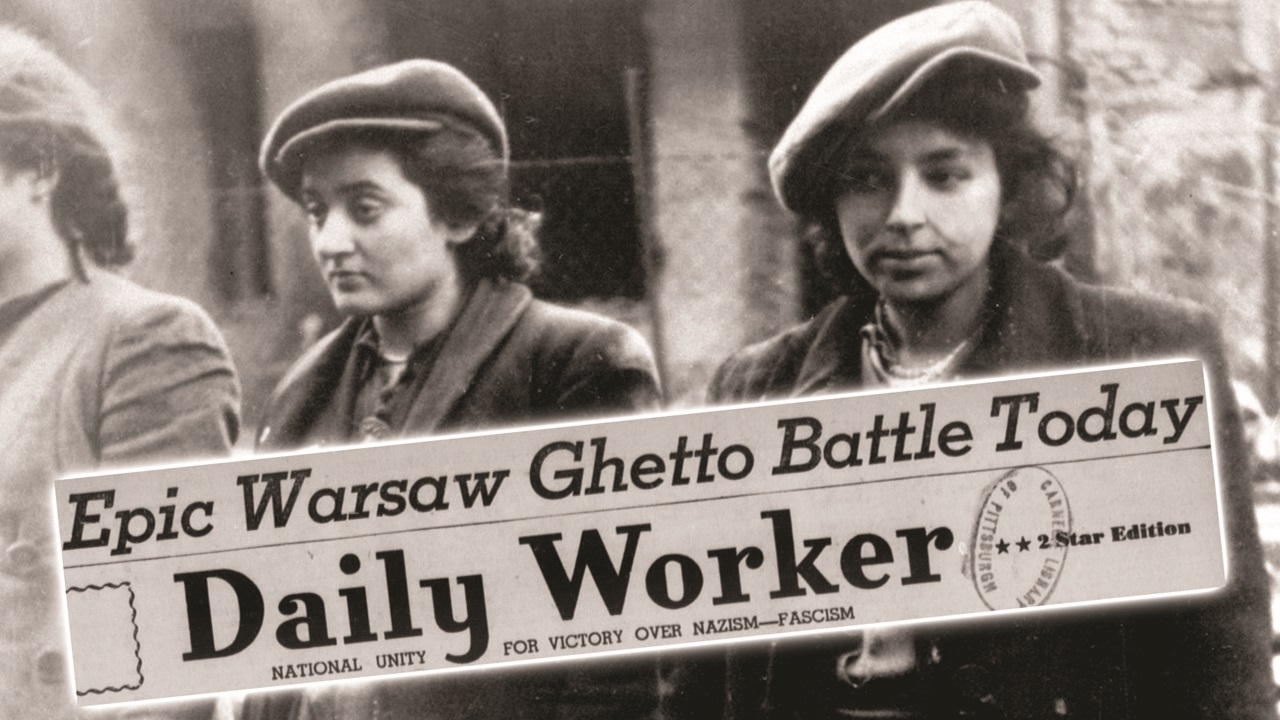
This article is part of the People’s World 100th Anniversary Series.
On April 19, 1943, the imprisoned Jews of the Warsaw Ghetto rose up against Hitler’s armies in a desperate attempt to block the Nazis’ effort to transport them all to the gas chambers of the extermination camps. Already the previous summer, more than 250,000 Jews had been stuffed into trains and shipped to the death factories from the Polish capital, and in April, Berlin ordered the SS to finish the job and clear the ghetto of its imprisoned Jews.
But the residents of the ghetto refused to surrender to the genocidal fate being imposed on them, even though they knew the Germans had them massively outmanned and outgunned. As a surviving commander of the left-wing Jewish Combat Organization later said, the rebels were determined “not to allow the Germans alone to pick the time and place of our deaths.” For them, martyrdom was preferable to surrender.
Germany had invaded Poland in 1939 as part of its colonialist campaign to conquer and settle lebensraum, or “living space,” in the east. Up to 400,000 Jews from all over Poland and other territories under Nazi control had been packed into the ghetto of Warsaw, forced to work as slave labor for the German war machine and subjected to endless brutality, disease, and murder.
Now, the Germans planned to methodically liquidate them all in one grand action. Refusing to go quietly, however, the Jews fought back. For 42 days, they held out against the Nazi armies. When it was all over, the Germans killed more than 56,000 Jews. Around 36,000 of those perished in the death camps.
The article below, published in the Daily Worker a year after the uprising, was produced with the Independent Jewish Press Service. It provided one of the most detailed eyewitness accounts of the ghetto uprising to date. It also told the world about the reality of the Holocaust underway in Europe, although in later years, many governments would deny they knew it was happening. Comparing the fight in Warsaw to the Battle of Stalingrad, the writers labeled it “The Battle of Ghettograd” and rightly characterized it as a decisive moment in history.
On the first Seder Night, about midnight, six tanks carrying German soldiers rumbled into the ghetto. The Nazis began throwing the customary cordon around one of its streets from which they were to take away Jews for deportation, as they had done so often on previous occasions. The Jews had been preparing for months.
For many weeks now, in flagrant defiance of the Germans, the walls of the ghettos had been plastered with posters calling upon the ghetto residents to be ready, for the hour of vengeance would soon strike. This was the hour of vengeance. On reaching the ghetto’s main street, the Germans were met by an intense fusillade. They died in the flames of their own exploded tanks. This was the revolt.
All able-bodied men and women were armed. Large houses were virtual forts. Every street was equipped with an arsenal and under command. Trenches were dug under cover of night. Cellers were ready as shelters. Children were assigned the task of messengers, to maintain contact between posts, to bring food and water to the fighters.
Early in the morning of the first day of Passover, detachments of ghetto guerillas stormed the ghetto workshops, where Jews were forced to make Nazi uniforms and the arsenals where the Nazi ghetto guards kept their weapons. The Jews took all the weapons on hand and outfitted all Aryan-looking members within their own ranks with German army uniforms. They also penetrated into the ghetto, seizing foodstuffs for distribution among the ghetto residents.
Captives of the Jews
In the morning, the ghetto was silent with little outward sign of what was going on in its dwellings, cellars, and subterranean passages, except for blue-and-white flags flying side by side with the Polish colors and Labor’s red banners from some of the windows. The German and Lithuanian police came as usual to escort the Jews who worked outside the ghetto, and the German soldiers arrived, as usual, to supervise the Jewish workers within the ghetto.
Cautiously, they walked down the deserted streets. Rounding corners, they were pounced on and disarmed by ghetto fighters striking from ambush. They were the ghetto’s first Nazi captives.
At noon, motorized military detachments raced through the streets of Warsaw, headed for the gates of the ghetto. Machine guns were brought up. Houses on the outskirts were blown up. The Germans knew that this was organized rebellion.
Late in the evening, the Germans withdrew, abandoning tanks and machine guns which had been put out of commission, and in the evening, the firing ceased. But the Jews stuck to their posts. The guard was reinforced. Flames and pillars of smoke rose from the ghetto.
All was outwardly quiet that night and the whole of the next day. Both sides were marking time. The third night was the Gestapo liquidation night, with the Jews venturing into the nearest headquarters, seizing arms and avenging in blood their brethren who had died at the hands of the Gestapo. It was a race for time, with the Germans rushing new arms transports into the vicinity of the ghetto and the Jews seizing or destroying them. The ghetto fighters were tense and trigger-nervous. They were equipped with bombs, machine guns, and anti-tank cannon.
The Germans were undecided as to how to cope with the situation. The military and the Gestapo were at loggerheads. The Gestapo, for once not daring to act on its own, blamed the military for procrastinating. The military, interpreting the revolt as retaliation for the Gestapo’s brutality, waited for orders from Berlin.
A jail is stormed

On the seventh day, using the time of German inactivity to reinforce its numbers and arsenals, the Ghetto Rebel headquarters received a plea from the Pawiak jail: “Release us, and we shall fight with you.” There were several thousand prisoners in the Pawiak tombs, most of them Jews and Poles, and even some deserters from the German army; and the Jews needed manpower.
On the eighth day of the ghetto revolt—with the streets still deserted and both Germans and Jews wary—500 Jews, in German uniforms, snuck out of the ghetto in small groups and reassembled in front of the Pawiak jail. The ruse they had intended was only partially successful. Shooting ensued. In the confusion of uniforms, however, the Jews broke into the jail and poured its human contents into Warsaw’s streets.
By morning, there were many German dead and the ghetto had several new detachments behind its barricades, the Pawiak jail detachments with German deserters in their ranks. Partisans returned from the woods to reinforce the ghetto army.
Berlin ultimatum
The German authorities had by then received their orders from Berlin. Detachments rushed from Galicia reinforced the Warsaw garrison. An ultimatum to the Jews called for immediate discontinuance of all resistance and the release of German captives or the ghetto would be razed to the ground.
The Jews countered with terms of their own demanding that for each German captive released by them, ten Jews be released from concentration camps in Poland. The Germans found this unacceptable.
The next morning, the great battle opened. Cannon opened up on the ghetto. Tanks rumbling into its streets were showered with bullets. Jewish suicide squads rushed in the face of German tanks, exploding them with hand grenades. Several hundred German soldiers died that day.
The German military authorities ordered that the ghetto be subjected to bombardment with incendiaries. That night was infernal, with fires sweeping the ghetto and buildings crashing on their defenders.
By morning, the ghetto had reorganized for battle under the new conditions. Houses on the outskirts were abandoned. Arms and food were removed into the center of the ghetto, where the main defense force was concentrated, but snipers and hand grenade throwers still lurked in ambush in the ruins of the “outer circle” to stall the German advance.
The Germans found every building, every doorstep bitterly contested. By evening, however, they had recorded gains toward the ghetto center.
The Jews sent messengers to the Polish underground proposing a revolt of the entire city, for the ghetto alone could not hold out much longer. Told that such a revolt would be premature, they held out alone.
The last stand

The ghetto ran out of food and water. The dead piled up. Epidemic raged. The last defenders, sick and feverish, stuck to their guns. On the 42nd day, the Nazis cordoned off the last target, a single building whose occupants still held out. It was a four-story structure, each of its floors a fortress.
After eight hours of constant firing, the Nazis gained entrance into the house but were balked by resistance on the ground floor. Resistance there quelled, they moved to the first floor, and here too were met by a fusillade. In the midst of the registers, on each staircase landing, and in each room, there was always the blue-and-white flag.
They carried their banner with them as they retreated to the roof, to the final trap. Late that night, it still waved from the roof. Then, the firing stopped, and for a moment, the flag disappeared. Soon, something wrapped in blue and white crashed to the street. It was the last defender, jumping to his death wrapped in the colors.
The next morning, the Germans announced that Ghettograd was liquidated. It was not. Some fighters still remained—in the rubble, in the ruins, in the catacombs. And the revolt has spread to other ghettos.
On the anniversary of the Ghetto Revolt, its environs are still being guarded. Among the ruins, the Germans sometimes see a grizzled figure, a surviving Jew. They rarely capture such alive. In their rags, these Jews still carry hand grenades, exploding themselves and their captors.
We hope you appreciated this article. At People’s World, we believe news and information should be free and accessible to all, but we need your help. Our journalism is free of corporate influence and paywalls because we are totally reader-supported. Only you, our readers and supporters, make this possible. If you enjoy reading People’s World and the stories we bring you, please support our work by donating or becoming a monthly sustainer today. Thank you!










